- Submissions

Full Text
Archaeology & Anthropology: Open Access
Archaeometrical Identification of the Iberian Amphorae Productions at the Area of the Ancient Laietania (Now Maresme): Some Considerations on Production and Distribution Patterns
Tsantini E*
Department of Prehistory, History and Archeology, University of Barcelona, Spain
*Corresponding author: Tsantini E, Faculty of Geography and History, Department of Prehistory, Ancient History and Archeology, Archaeological and Archaeometric Research Team of the University of Barcelona (ERAAUB), University of Barcelona, C/Montalegre 6-8, 08001 Barcelona, Spain
Submission: October 27, 2017; Published: January 30, 2018

ISSN: 2577-1949Volume1 Issue4
Abstract
In the present contribution an integrated archaeological and geochemical study of Iberian amphorae found at the indigenous settlement of various Laietanian sites are presented. Two of the analysed sites are production sites and three are consumption sites. Two chemical groups were identified. The first is the reference group of the kiln site of Rierade Sant Simó and the second is the Paste Compositional Reference Group of the Iberian village (consumption site) Puig Castellar. The final results proved, on one hand, a diversification of the productions on the various analysed sites and, on the other, some wider commercial contacts. The chemical complexity reveals the existence of a multiplicity of productions in each geographical area and clearly indicates a commercial interaction between the Laietania and the Cossetania, at least. Adding to those results the typological information too, a certain standardization of forms in each of those regions was observed.
Keywords: Iberian; Pottery; Amphora; Production distribution; Commerce; Archaeometry; Chemical analysis; Provenance; Origin
Introduction and State of Art
Figure 1: The Iberian territories in the NE of the Peninsula and the different Iberian amphorae types, defined for the different areas.

During pre-Roman times, different tribes or ethnoi occupied the Iberian Peninsula. Each had its own economic, social, legal, and administrative system and spoke its own language. Nevertheless, all of them had a global cultural identity which archaeologists have identified as 'Iberian culture'. The Iberians occupied the region that today is equivalent to southern France, Catalonia (North- east Spain) and Valencia (East Spain) (Figure1). During this period there were two great economic and commercial impacts on the Iberian Peninsula. Both had significant consequences on the evolution of the Iberian society:
a) The Phoenician Commercial expansion and
b) The Greek commercial expansion.
Both colonization processes were essential for the establishment of no mad Iberian populations in stable habitats and for the development of autonomic and autarchic tribal units with a global economic system based on agriculture and stock-breeding.
Figure 2: The sites where Iberian kilns and/or Iberian pottery production related structures have been located.
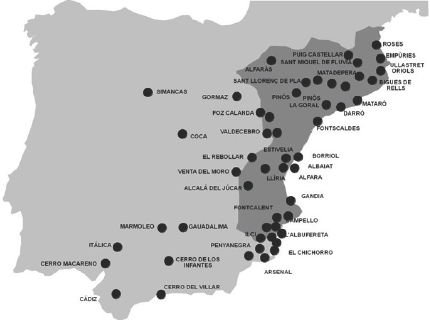
There are numerous pre-roman kiln sites found in the Iberian Peninsula (Figure2) [CollContesa, 2000], however, very few were producing Iberian amphorae. Iberian amphorae were originally classified as type Mañá B3 [Miró 1983-84] which derived from older Phoenician models. The evolution of proper Iberian types varied across the different regions of the Iberian Peninsula (Figure 1) (e.g. [1-7]). Four main typological categories have been defined for the northeastern coast of the Iberian Peninsula (currently in the Spanish region of Catalonia) and eight for the Levantine coast (in the present-day region of Valencia, Spain) [6,7].
Within the four principal categories that pertain to northeaster Spain, several types and variants have been defined. Type 2A (Figure 1), dated from the 5th to 3rd centuries BCE and derived from archaic Types that all belong to the generic category of Type 1 [8,9] is most abundant in northern Catalonia, with several examples found at Ullastret and Empúries (Indiketes in Figure 1), and only a few examples in Laietania. No kilns producing this type have been discovered to date. Types 2B (Figure 1), dated from the second half of 6th to the 2nd century BCE, appear in large numbers in the Laietanian region, with few examples in Cossetanian area and in Indiketa (Figure 1). The kilns discovered at Riera de Sant Simó [10,11], Vista Alegre 17 [12] and Can Badell or Vedell [Hernández 1983a, b] are all located on the Laietanian coast. This leads to the assumption that these types might be a local or regional Laietanian product. Types 2C (Figure 1), dated from the end of the 3rd to 1st century BCE [6,8], are later types and frequently found in Cossetania (Figure 1). The main kilns that produced types 2C are at Darró [9], Hortesde Cal Pons (Pontóns; Alt Penedès) [12] and Fontdelsigols, in the vicinity of Hortesde Cal Pons. Finally, types 2D (Figure 1) are dated between the 5th and 3rd centuries BCE, like types 2A, and are mostly found in Indiketa (modern-day Empùries and Ullastret). Although no kilns producing these types have been located to date, it is assumed to be a local/regional product of the region.
A specific chronological evolution of the types of Iberian amphorae from the Levantine coast (Edetania, Contestania, etc.) has been published elsewhere [13,14] (Figure 1). The current regions of Castellò and Valencia were inhabited by the Ilercavones, Edetani and Bastetani (Figure 1) during the Iberian period. Meanwhile, the remaining province in the region, Alicante, was populated by the Contestani. The archaeological record has revealed some types of amphora (I-1, I-2 and I-4) only in Iberian Contestania (Figure 1) (southern Alicante nowadays) and others, such as I-7 and I-8, only in Edetania (northern Valencia). Nevertheless, type's I-5 and I-6 have appeared in both areas [6,7]. So far, four areas of production of Iberian amphorae have been distinguished in Edetania and Constestania (Figure 1). A kiln site was found at the coastal Edetania area of Arse-Saguntum (Figure 1), with no evidence of early amphorae types. The abundance of the late I-8 type (Figure 1), both at the kiln site and along the River Palancia, suggest that this specific type might have been produced there. Towards the inner parts of Edetania, around the ancient area of Kelin, there is another workshop known as La Casa Guerra (Requena), which seems to have produced amphorae between the 4th and3rd centuries BCE, although the extremely fragmented state of the material does not allow their type to be defined. It is believed that this kiln might have been producing type I-6, since this specific type is the most abundant in this area. In the Contest an area (Figure 1), the best-known Iberian amphora kiln site (with 6 kilns working at the time) is Campello (Alicante). At Campello, there are clear archaeological evidences on the production of type I-3 (related to the trade of garum: fish sauce) and I-5, although the manufacture of types I-2 and I-4 cannot be excluded, since they are frequently found in this geographical area as well. In the area surrounding Ilici (Contestania), another area of pottery production has been located that seems to be related to the production of types I-4 and I-5. Finally, various kilns producing pottery from the Iberian period up to the Islamic period were discovered at Cerro de les Balsas (Albufereta, Alicante) [Rosser Liminana et al. 2003]. Two of the kilns discovered at this site and a workshop produced all kinds of Iberian pottery (amphorae and common domestic wares). The amphorae produced there mostly include type's I-3 and I-5. In contrast, in Ilercavonia (Castellò), only one kiln site, Mas d'Aragó (Cervera Del Maestrat, Castellò) is documented in the literature and it is not clear what types of amphora were produced there. The abundance in the region of a variant (maybe an imitation) of the northern Cossetanian type 2C has led to the hypothesis that this was the type produced at Mas d'Aragó [7,15].
Provenance studies applying mainly chemical (XRF) and mineralogical (XRD) characterization published to date comprise Iberian amphorae dated to between the 6th and 2nd centuries BCE selected from 22 archaeological sites (Figure 3) (Table 1). These sites are located in the littoral and pre-littoral areas of contemporary Catalonia (ancient Laietania and Cossetania); in Riberad’ Ebre, Alt Empordà and Osona (ancient Ausetania, Indiketa and Ilercavonia); in the central and southern coasts of Valencia and Alicante (ancient Edetania and Contestania); and in the Balearic Islands (mostly in Menorca and Mallorca) [7,15-18]. Within these sites there are two kiln sites, Riera de San Simó (Laietania) and Hortes de Cal Pons (Cossetania); two kiln dumps, Vista Alegre (Laietania) and Campello (Contestania); one possible kiln at Fonsdels igols (Cossetania); and seventeen consumption sites (Figure 3).
Figure 3: Left: Archaeometrically studied Iberian settlements, up to date, in the Peninsula and Right: The reference Groups and Paste Compositional Reference Units of Iberian Amphorae identified in previous archaeometrical associated to each one of the site or broader geographical areas..
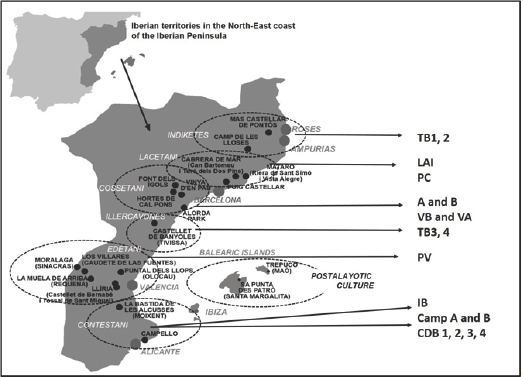
The Archaeometric study allowed establishing four Reference Groups (RG's) (as defined by Picon [19]), associated with specific production sites, indicated as LAI, VA, Camp A and Camp B (Figure 3) and seven Paste Compositional Reference Units (PCRU's) [20], associated with consumption areas and labelled as PC, PV, VB, A, B, IB, TB. The RG's are related to specific production sites, with certainty, since the material was sampled at the kilns [6,15]. Specifically, LAI represents the reference group of the kiln site of Riera de San Simo that has been also archeologically associated to the closely located kiln dump of Vista Alegre (Iberian Laietania, now Martaro) (Figure 3). VA corresponds to the production of the kiln of Hortes de Cal Pons (northern Cossetania, now Villafranca Del Penedes) (Figure 3) and finally Camp A and B are two variants of Campello's kilns (Contestania, now Alicante; Illeta de Banyets) (Figure 3). As for the PCRU's, some of them can be related to specific regions according not only to the typological and archaeological information but also to the geochemical compatibility of the groups with specific geological areas [15] (Table 1). PC is related to the site of Puig Castellar (Iberian Laietania, now Mataro). PV is geochemically compatible with certain non-calcareous Ordovitic and Siluric slatic and quartzitic areas (IGME 1982-Lliria) of Edetania (now a days it would be the broader area of Lliria) [20]. VB seems to be a variant of the RGVA, and it can be therefore associated to northern Cossetania (now Villafranca de Penedes). PCRU'S A and B (Figure 3) are two variants of the same production that geochemically fit the continental and/or transitional quaternary areas of Southern coastal area of the Cossetania (Figure 3) (now geographical area of Garraf). Finally, TB is composed by individuals sampled at different consumption sites (Castellet de Banyoles, Mas Catellarde Pontos and also Alorda Park) (Figure 3). It is a broader chemical cluster with some subgroups that exhibit minor chemical differences in- between them and they cannot be related, at least at the present, to none of the studied areas. Even though the groups VA and VB are quite similar, certain differences were observed that indicate that each one corresponds to a different chemical group. Finally, previous works [6,15-18] in consumption sites from the Balearic Islands, has help to define the so-called PCRUIB, a chemical group that so far contains only individuals from the Balearic Islands. Nevertheless, IB’s chemical composition suggests that the raw materials are associated to specific geological formations from the area of Alicante.
To summarize, the results from these previous works [6,1518] integrating chemical and typological suggest that, each general type (Figure 1) was produced by different workshops at regional scale. For instance, type 2B is represented by the Laietaian chemical groups LAI and PC, and type 2C by the Cossetanian chemical groups A, B, VA and VB (Table 1). This clearly indicates that there might be a certain typological standardization in each of the regions under study, but that there was not a chemical or technological homogeneity nor within the same geographical area nor between different areas. Thus, Iberian amphorae produced at a local level (town or country site) used different, yet apparently local, raw materials and were fired in their own specific pottery kilns applying different technological processes despite adopting regional typologies.
Methodology and Sampling and Short Description of the Sampled Archaeological Contexts
Methodology
Table 1: Summery of the description of the up to now identified Iberian pottery productions in pervious works.

* RG= reference Group
* PCRU=Paste Compositional Reference Unit
Table 2: Description of the analysed material from the different sites and information on the archaeological sites.

The studied samples from the area of the Laitenaia are listed in Table 2. The chemical composition of the samples was determined by XRF using a Philips PW2400 spectrometer with a Rhexcitation source. A 25g specimen (to ensure it was representative) from each shard was powered and homogenized in a tungsten carbide mill and dried at 105 0C for 24h. The major and minor elements were determined by preparing duplicates of glassy pills in a Philips Perl'X-3 high induction furnace using 0.3g of the powdered specimen in alkaline fusion with 5.7g of lithium tetra borate at 1/20 dilution. Trace elements and Na2O were determined in powdered pills made from 5g of dried specimen mixed with 2ml of Elvacite 2044 agglutinant, placed over boric acid in an aluminum capsule and pressed for 60 sat 200kN. The concentrations were quantified using a calibration curve based on 60 International Geological Standards. A total of 29 compounds and elements were determined: Fe2O3 (as total Fe), Al2O3, MnO, P2O5, TiO2, MgO, CaO, Na2O, K2O, SiO2, Ba, Rb, Mo, Th, Nb, Pb, Z r, Y, Sr, Sn, Ce, Co, Ga, V, Zn, W, Cu, Ni and Cr. The loss on ignition (LOI) was determined by firing 0.3g of dried powder at 950 0C for 3h. Statistical analysis of chemical data was performed using S-Plus software [Mathsoft 1999].
Description Of The Studied Laietanian Production Sites
The kiln of santa cecília, riera de sant simó (Mataró)
La Riera de Sant Simó is located in the northeast of Mataró (Figure 4 & 5: A), in the area of Santa Cecilia. In 1968, the archaeological prospecting was carried out and the subsequent excavations highlighted the existence of three Iberian furnaces at a distance of three meters from each other (Figure 4). The Iberian chronology of the kilns was established according to the typology of pottery found at the site. The pottery was Iberian amphorae and common wares. The only fragment of imported amphora was Greco-italic that dates the kilns between the 3rd and 2nd centuries BCE [11]. In 1973 one of these kilns was excavated to study the structure (Figure 5: A). Most of the material that is preserved at the Mataró Museum, today, corresponds to fragments of Iberian amphora on the Catalan coast, belonging to variant 2B (Figure 4).
Figure 4: Above: One of the kilns of the site of Rierade Sant. Simó and the typology of the Iberian amphora it was producing. Bellow: The kiln dump of Vista Alegre during the excavation and the types of amphora discovered at the site.
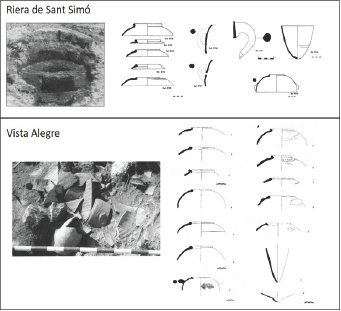
Figure 5: A: The plant of the site of Rierade Sant Simó and the section of the kilns; B: The section and the plant of the kiln dump of Vista Alegre; C: The plant of the Iberian Village of Can Bartomeu; D: The plant of the Necropolis of Turró dels dos Pins; E: The plant of the village Puig Castellar and the typology of the Iberian amphora discovered at the site.

The kiln dump of vista alegre (Mataró)
The kiln dump excavated at the Camino de Vista Alegre [12] that located southwest, next to the Iberian kiln of Riera de Sant Simó, archeologically seems to be associated to this kiln (Figure 5: B). The dump is situated next road that goes from the road of Valldeix (Riera de Sant Simó) to the neighborhood of Vista Alegre. Between 1981 and 1991, several archaeological surveys were carried out. Finally, in 1991 the excavation was completed [12]. The sector 10000 two archaeological layers were located that provided building materials (bricks and tiles), fragments of mural paint, large amount of Iberian ceramics (handmade common wares, amphora and typical Catalan grey wares). One part was Roman pottery: Italic and African Sigillata. The other part (in UE10007: Figure 5: B) was Iberian amphorae located at sector 10000 that dates the Iberian layer to the 3rd. century BCE. The amphorae's typology corresponds mainly to subtype 2B (Figure 4).
Description of the Consumption Sites
The site of Can Bartomeu (Vall de Cabrera de Mar)
The importance of the Cabrera de Mar valley in terms of occupation models during the Iberian era is well known [21]. Cabrera de Mar is located in the north of Barcelona (Figure 5: C), next to Can Segarra and the old field called Can Bartomeuthatisan Iberian village is about 300 meters from the oppidum of Burriac. Two chronological phases were defined for this Iberian village. The moment of its construction that dates to the beginning of 2nd century BCE, and a moment of re modelling/reconstruction and/or restructuration of the site, which dates to the second half of the 2nd century BCE. 30 silos (grain storage) surround the village (Figure 5: C) that were chronologically grouped into two groups. The first group, which contains 15silos, seems to be quite homogeneous and dates between the second half of the 3rd century BCE and the beginning of the 2nd century BCE. The second group is formed by 13 silos that are quite heterogeneous. Two of them were used up to the middle of the 2nd century BCE and eight of them were used up to the last quarter of the 2nd century BCE and/or the beginning of the 1st century BCE [22]. Among the Iberian ceramics recovered in this site there are a large number of Iberian amphorae, however they haven't been defined typologically, because of the fragmented state they were found.
The necropolis of turó dels dos pinos (Vall de Cabrera de Mar)
Another probable consumption site is the Iberian necropolis of the Turó dels Dos Pins [21] that is located in the municipal district of Cabrera de Mar, such as the Can Bartomeu. The necropolis (Figure 5: D), in fact is located in the lower part of the Cerro dos Pins. The discovery of the site was accidental, in 1986, owed to plunder of some of the tombs. The necropolis is formed by 94 tombs (Figure 5 D) that surround a small rural settlement [22]. The tombs were separated into three different chronological groups: the first dates between 250 and 200 BCE, the second, between 220 and 200 BCE and the third, between 200-180 BCE. The pottery discovered at the Necropolis is very important. It contains imported pottery. Nonetheless, the 90% is indigenous. The Iberian amphora mainly belongs to the subtypes 2B [10] (Figure 5: D), only few of them fit to the subtype 2C.
The Iberian village of puig castellar (Santa Coloma de Gramenet)
The Iberian settlement of Puig Castellar [23] is located at the top of the hill with the same name, 303m above the Sea level in the Santa Coloma de Gramenet, in the northeast of Barcelona. The site (Figure 5: E) was discovered by Father Joan Pala and the historian Ferran Sagarra and Sis car, in 1998 and it is provided ceramic material, currencies, metal objects, remains of fauna and human remains. With regard to the occupation of the settlement, two different phases have been distinguished [23]. The first corresponds to the construction of the first habitat and the creation of the main urban fabri candidates to the end of the 5th century BCE and/or the beginning of the 4th century BCE. The second phase dates between the end of the 3d century BCE and the beginning of the 2nd century BCE and it is related to some constructive modifications and finally the abandonment of the site. For this second phase, a significant increase in Iberian amphorae was observed (Figure 5: E) [23].
The identification of the productions of kilns and kiln sites situated at the area of the Iberian Laietania (today called Maresme situated at the North East Catalan Coast)
The summary of the information on the analysed material is given in Table 2. Whereas, in Table 3 the normalized chemical composition of the analysed individuals is presented (see also Tsantini 2007). Most of the studied sites are situated in a geological area which is characterized by the main presence of granitic and/or granodioritic volcanic sequences. The chemical composition of the raw materials of that kind, normally, is characterized by relatively high Ba and MnO concentrations. Table 3 reflects exactly that fact for most of the analysed individuals. This is a compositional indication that the raw materials would be local/regional for most of the analysed pottery. For the statistical treatment, some of the elements determined (P2O5, Pb, Mo, Co and W) were left out to avoid misinterpretation due to very low values and or possible contamination and/or alterations.
The purpose of chemical analysis in the framework of provenience studies is to compare the chemical composition of the analysed individuals trying to identify clusters. This is normally done by using statistical treatments. If the statistical treatment is not done cautiously, erroneous results can be obtained, due to various problems that the compositional data present [24,25]. To avoid these problems, the raw data set is transformed into logarithms (additive log ratios) following the considerations of Aichison and Buxeda.
One of the most important steps in a chemical study, since the objective is to compare the composition between individuals, is to calculate somehow the existing variation within the dataset. The simplest way to control this variability is the calculation of the compositional variation matrix (MVC) [26]. This matrix includes all the necessary information to measure the variability in compositional data, such as the total variation and the degree of variability introduced by each chemical element in the data set. The total variation (vt) quantifies the total variability and if it exceeds 0.3 indicates that the analysed material is chemically heterogenic or polygenic that means heterogeneous chemical composition and diversified origin and/or provenience. In other words, the existence of more than one production/group. The variation matrix is used to define the most variable chemical elements and also the less variable chemical element that used as divider in the logarithmic transformation, as well.
To examine chemical variability in our dataset, first, we calculated the Compositional Variation Matrix (CVM) (Table 4), on the following sub-composition: Fe2O3, TiO2, CaO, K2O, SiO2, Al2O3, MgO, Ba, Ce, Cr, Cu, Nb, Ni, Sr, V, Zn and Zr. The total variation (vt) is 0.9778 that suggests some chemical heterogeneity [27]. After a logarithmic transformation using SiO2 as a divisor, a Cluster Analysis was performed on that same sub-composition. The results from this analysis applying the squared Euclidian distance and the centroid agglomerative algorithm, is the cluster tree presented in Figure 6.
Several observations can be done, after these first results. First, AMI211 (indicated with a red circle in Figure 6) is a chemical outlier with very high Ba wt%. AMI200, AMI023 and AMI024 (indicated with a pink circle in Figure 6) present higher CaO percentage sand lower Na2O. At the same time, the chemical data indicates some similarities between AMI023 and AMI024, but not between these two and AMI200. AMI032, AMI046, AMI047, AMI173, AMI175, and AMI177 are separated from the rest of the individuals, in a lower ultra metric distance. The similarities that these individuals present (border to low CaO; relatively high Al2O3, Fe2O3 and Na2O) compared to the rest, grouped in the blue rectangle, in Figure 6, indicate similar geochemical origin (raw materials might come from the similar deposits). However, they don't belong to the same production.
Figure 6: Cluster tree, on the 114 individuals, resulting from the cluster analysis performed using the Square Euclidean distance and the centroid agglomerative algorithm on the log ratio transformed sub composition Fe2O3, Al2O3, MnO, TiO2, MgO, CaO, Nap, K2O, Ba, Rb, Nb, Zr, Y, Sr, Ce, Ga, V, Zn, Ni, Cr and Nb using SiO2 as a divisor in the log ratio transformation.
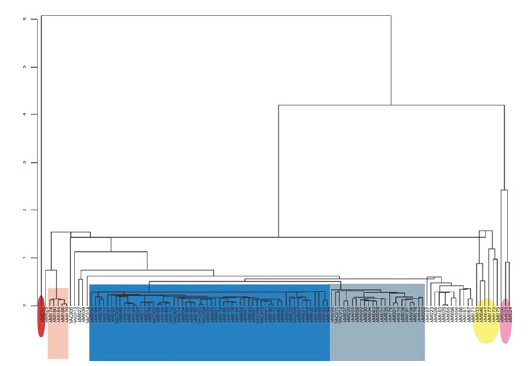
After this first approximation, therefore: AMI023 AMI024, AMI032, AMI46, AMI47, AMI173, AMI175, AMI177, AMI200 and AMI211 cannot be well classified into a specific group since they present important differences from all the analysed material, coming from the Laietania. From these individuals: AMI023 AMI024 and AMI032 were sampled at the site Can Bartomeu. AMI046, AMI047, AMI173, AMI175 and AMI177 in the Iberian village of Puig Castellar and AMI211 and AMI200 came from the kiln dump of Vista Alegre, which is considered the kiln dump of the Laietanian workshop of Riera de Sant Simó (Mataró). Another individual VAC005, which is a common ware, is separated from the rest, and it was sampled in Vista Alegre.
We recalculated the CVM excluding of the above-mentioned chemical outliers (AMI023, AMI024, AMI032, AMI046, AMI047, AMI173, AMI175, AMI177, AMI200, AMI211 and VAC005), and the total variation is significantly lower: 0.4293. A vt of that range, certainly, indicates a common geological origin for all the reaming pottery, even if, they not necessarily form part of the same chemical group (or production). A new cluster analysis was performed in those remaining 103 individuals. The cluster tree of that analysis is presented in Figure 7. According to this graph, there are five individuals: AMI174, AMI180, AMI184, AMI166 and AMI170 that form a small chemical group (PC in Figure 7). All five were sampled at the Iberian site of Puig Castellar. From geological point of view, Puig Castellar is located to the north of Barcelona, in the area of the hill Coixarola, on a metamorphic and sedimentary ground, where the calcareous rocks are relatively abundant, opposite to the volcanic ground of the Maresme, where the rest of the sites are situated and, where the acidic igneous rocks like granite and granodiorite are dominant.
In Table 3, important similarities in the chemical composition of these five individuals, and the ommondifferencesfromrestoftheanalysedmaterialcanbeobserved. PCisacalcareousgroup (CaO between 8.98% and 10.76%) that also present lower concentrations in Fe2O3, MnO, TiO, Na2O, Th, Nb, Zr, Y, Ce, V, Zn and Ni. The calcareous character of this group is compatible with the location of the site where these five individuals came from. Therefore, the probability they were produced at this site and/or this are/region is high. Nevertheless, since there is no archaeological information on the existence of kiln/s on the site or its surroundings, it can only be identified as Paste Compositional Reference Unite (PCRU) of Puig Castellar. The mean weight percentage of each element and their standard deviations can be seen in Table 5.
AMI029 is separated from PC since the only similarity with it is its calcareous character (14.32%). In this same cluster tree (Figure7) there is another larger group indicated with LAI that is formed by 59 individuals. The samples specified by the grey rectangles in Figure 7, at the right of LAI, according to the chemical data (Table 3) present some relatively important chemical differences (showed in this Figure 7) according to which they don't fit 100% inside this group. Despite that, in production terms, they must be local/regional variants of the group LAI.
Figure 7: Cluster tree, on the 103 individuals, resulting from the cluster analysis performed using the Square Euclidean distance and the centroid agglomerative algorithm on the log-ratio transformed sub-composition Fe2O3, Al2O3, MnO, TiO2, MgO, CaO, Na^O, K2O, Ba, Rb, Nb, Zr, Y, Sr, Ce, Ga, V, Zn, Ni, Cr and Nb using SiO2 as a divisor in the log ratio transformation.
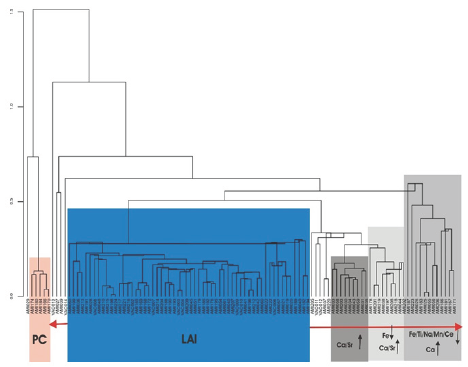
Figure 8: The cluster of the Reference Group (RG) of the kilns of Rierade Sant Simó: LAI, with red circle the individuals from Puig Castellar are indicated, with light blue stars the individuals of the kiln of Rierade Sant. Simó, with yellow rectangles the individuals from Turró dels Dos Pins, with light green triangles the individuals from Can Bartomeu.
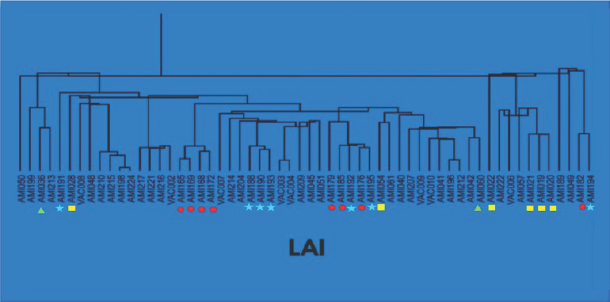
Finally, LAI (Figure 8) contains 59 individuals. Between them are all the individuals sampled from the kilns of Riera de Sant Simó. It also comprises the 35 individuals from Vista Alegre, a kiln dump archaeologically related to the kilns of Rierade Sant Simó. Since those are productions sites LAI can be identified as the Reference Group (RG) of the kiln of Rierade Sant Simon without any doubts. It is important to mention that one of the amphora included in this group (AMI053) have been sampled at the Cossetania, three come from Can Bartomeu (AMI036, AMI036 and AMI057), six from Turó dels Dos Pins (AMI019, AMI020, AMI021, AMI022, AMI028 and AMI054), eight from Puig Castellar (AMI182, AMI 165, AMI169, AMI168, AMI172,AMI179, AMI185 and AMI176) and finally eight from the kiln site of Riera de Sant Simó (AMI188, AMI189, AMI190, AMI191, AMI192, AMI193, AMI194 and AMI195), which represents the total number of the sampled amphorae at this site, and the rest of the individuals belonging to the group coming from the kiln dump of Vista Alegre. The main typology of this production can be seen in Figure 9 and its mean chemical composition and the standard deviation in each analysed elements is given in Table 6.
Figure 9: The cluster of the Reference Group (RG) of the kilns of Rierade Sant Simó: LAI, with red circle the individuals from Puig Castellar are indicated, with light blue stars the individuals of the kiln of Rierade Sant. Simó, with yellow rectangles the individuals from Turródels Dos Pins, with light green triangles the individuals from Can Bartomeu.

Discussion and Conclusion
The chemical results lead to various conclusions. Regarding the Laietania (Figure 1), half of the individuals (50.43%) are classified in the RG of Rierade Sant Simó (LAI), while only the 5.22% belongs to the PCRU of Puig Castellar (Figure 10: A). The 24.35% of the non- clearly classified individuals are chemically related to Riera de Sant Simó's production. Their chemical composition indicates a common geochemical origin, and therefore, they must be regional variants of the group LAI. 17.39% of the individuals cannot be classified within any Laietanian group. However, they preserve geochemical relation with the Laietanian area. Finally, the 2, 61% individuals that are basically constituted by three individuals sampled at Can Bartomeu (AMI023, AMI024 and AMI029) and typologically identified as 2C, is not related to the Laietanian area at all. All the individuals (100%) sampled at kilns of Riera de Sant Simó belong to the LAI. That is why LAI was identified as the reference group of that kilns.
More than a half of the individuals (57.63%) sampled at the dump of Vista Alegre is classified into LAI (Figure 10: B) and, generally, the 93.22% is somehow chemically related to this same production. There is only 6.78% that cannot be classified, nor can be related to the Laietanian productions (Figure 10: B). Regarding, now, the individuals sampled at Can Bartomeu (Cabrera de Mar) a high percentage is of unknown origin. 16.67% cannot even be related to the Laietanian area, while exactly the same percentage (16.67%) is clearly classified as LAI. The 11.11% seems to have Laietanian origin, even if they not belong to LAI (Figure 10: C). On the other hand, the 75% of the Iberian amphora sampled at production of La Riera de Sant Simó (LAI) (Figure 10: E), while the the Necropolis of the Turró de dos Pins belongs to LAI and the rest of the individuals are distributed equally among unclassified, Laietanian origin and unclassified non-Laietanian origin (Figure 10:D). With regard to the pottery sampled at Puig Castellar (Sta. Colomade Gramanet, Barcelona) 31.82% is classified within the 27.7% of constitutes the PCRU of this same consumption site (PC). 13.64% is unclassified but geochemically related to the Laietania area and 27.27% cannot be related to the Laietanian area at all (Figure 10: E).
Figure 10: A: Percentages of the productions and unclassified individuals at the Laietanian area; B: Percentages of the individuals classified into LAI and the non-classified ones in Vista Alegre; C: Percentages of the different productions and non-classified at the site of Can Bartomeu; D: Percentages of the different productions and non-classified at the Necropolis of Turró dels Dos Pins; E: Percentages of the different productions and non-classified at the site of Puig Castellar; F: The proportion of the participation of each studied site in LAI (the RG of Rierade Sant. Simó) and G: The proportion of the participation of each studied site in the non-classified material.

Considering LAI, the RG of the Iberian kilns of La Riera de Sant Simó, it includes the totality (100%) of the samples from that specific kiln site that corresponds to the 13,56% of the production, while 57,63% of the individuals that belong to LAI were sampled at the kiln dump of Vista Alegre. A fact that clearly evidences that Vista Alegre was the kiln dump of Riera de Sant Simó. Additionally, the 11.86% of this production is represented by individuals coming from Puig Castellar, 10.17% from Turó de Dos Pins and 5.08% from Can Bartomeu (3 individuals).
It is important to mention that within LAI there is one single individual (AMI053) that was sample data Cossetanian site of Alorda Park (Calafell, Baix Penedès). This individual represents a very small part of the Laietana production (1.69%), nevertheless, it is clear indication that Iberian amphorae produced in the Laietanian site of Riera de Sant Simó travelled to southern Cossetania. This is an indication of exchange between the Cossetania and Laietània [28].
To conclude, there are other important facts to emphasize. LAI integrates both amphora and common wares that indicates the employment of the same recipe for the different type of ceramics. Additionally, from the amphorae sampled at Turró of the Dos Pins two that match with the smallest variants of the sub type 2C, which is archaeologically assigned to the Cossetania, belong to the RG of a Laietanian kiln site (Riera de Sant Simó), where the individuals mainly classified as local/regional subtypes: 2B, witnesses that the workshop, at least, produces imitations of other non-local Iberian amphora types. These specific results also stress out the local/ territorial character of the productions, which means the use of local/regional raw materials and the maintenance of a technological sequence in the production.
Another important aspect is that 24.35% ofthe analysed material of Laietana origin is chemically related to the kilns of Riera de Sant Simó, meaning similar geochemical origin, without necessarily having been produced at this same workshop (Figure10). Other 7.39% of the material is not classified within the LAI production, however geochemically related to the Laietanian area (Figure10) and only the 2.61% is of non-known origin (Figure10) and all of them sampled from Can Bartomeu. Regarding the composition of the non-classified individuals (Figure 10: G) 60% of the individuals were sampled at Can Bartomeu, 20% at Vista Alegre, 15% at Puig Castellar and only 5% at Turró dels Dos Pins. Therefore, the sight, where highest the diversity is Can Bartomeu.
To finish, the diversification of the participation of the different analysed sites in LAI (the reference group of the kilns of Riera de Sant Simó) evidences that this kiln was providing with Iberian pottery different areas of the Laietanian region. However, the diversification of the productions of the various analysed sites also indicates some wider commercial inter-relations.
The high percentage of the unclassified material points to the existence of high divergence of productions that still have to be identified in the future. The results clearly indicate a commercial interaction between the Laietania and the Cossetania, for the moment. The chemical complexity reveals the existence of a multiplicity of productions in each geographical area, which still complicates the interpretation of all the available information. Adding to those results the typological information, even if, there is a diversification of production in the geographical areas (mean use of local/regional raw materials and specific technological processes in each kiln and production site) there is a certain standardization of forms in each of those regions. These results, of course, can be, and should be modified and expanded with future analysis.
References
- Brugera R (1994) Tipologia-cronologia de les àmfores ibèriques de l'area Del Penedès. Miscel lània Penedesenca 24: 77-88.
- Sanmartí J, Bruguera R, Morer J (1998) Les àmfores ibèriques a la catalunya meridional. Quaderns de prehistòria i arqueologia de castellò 19: 267-290.
- Sanmartí J, Bruguera R (1998) Les àmfores ibèriques del "celler” del puig de sant andreu (ullastret, baix empordà). Cypsela 12: 183-194.
- Guerrero V (1993) Navios y navegantes en las rutas de Baleares durante la prehistoria. El Tall, Palma deMallorca, Spain.
- Guerrero V, Quintana C (2000) Comercio y difusión de ánforas ibéricas enBaleares. Quaderns de Prehistòria i Arqueologia de Castellò 21: 153188.
- Ribera LA (1982) Las ánforas prerromanas valencianas (fenicias, ibéricas y púnicas). Serie de Trabajos Varios del SIP 73: 144.
- Ribera A, Tsantini E (2008) Las ánforas del mundo ibérico. In: Bernal D, Ribera A (Eds.), Cerámicas hispanorromanas. Un estado de la cuestión. XXVI Congreso Internacional Rei Cretariae Romanae Fautores, Cádiz, Spain, pp. 617-634.
- Sanmartí J, Bruguera R, Miñarro M (2004) Las ánforas ibéricas de la costa de cataluña. D.a.m 27: 379-403.
- Pons E (1982-1983) Acerca de unos hornos ibéricos en la Riera de Sant Simó (Mataró). Laietania 2-3: 185-200.
- Ribas BM (1983-84) Un taller d'àmfores a Mataró. Pyrenae 19-20: 281285.
- López A, Fierro J (1988) L'època ibèricaa Darró. Hipòtesisi evidències proporciona desper les darreres excavacions. MisceWània Penedesenca 11: 37-68.
- CODEX SCCL (1995) Camí de Vista Alegre, a autopistes i arqueologia. Memòria de les excavacionsenla prolongaciódel' autopista. Autopistas CESA, Generalitat de Catalunya, Barcelona, Spain, A-19: 94-117.
- Asensio VD (1995) Memòria de l'excavació al jaciment del Corral/Les Hortes de Cal Pons (Pontons, Alt Penedès). Diposit digitalde catalunya, Generalitatde Catalunya Barcelona, Spain.
- Borras C, Selma S (1989) El centro de producción de cerámica de Más d'Arrago. Un complejo ibero/romano. In: Actas Del XIX congreso nacional de arqueologia, Univesidad de Zarragoza, Zaragoza, Spain, pp. 667674.
- Tsantini E (2007) Estudi de la producción i distribució d'àmfores ibèriques en el NE peninsular a través de la seva caracterització arque- omètrica. University of Barcelona, TDX, Spain.
- Tsantini E, Buxeda J, Gurt JM, Madrid M, Miñarro M, et al. (2005a) Amphorae production in the pre-Roman northeast of the Iberian Peninsula, and evidence of trade to the Balearic Islands. In: Prudenico MI, Dias MI, Wearenborch JC (Eds.), understanding people though their pottery, Instituto Portugués de Arqueologia and Ministerio da Cultura, Lisbon, Portugal, pp. 279-286.
- Tsantini E, Buxeda J, Gurt JM (2005b) Estudi arqueométrica de les àmfores ibériques Del Puig Castellar (Santa Coloma de Gramenet). In: Mercadal O (Coord.) Món ibéric Als països catalans, Insitut d'Estudis Ceretans, Puigcerdà, Spain, pp. 312-318.
- Tsantini E, Jiménez-Piqué E, Montana G, Randazzo L (2015) Strength of pre-Roman amphorae: Comparison of the different types. J Arch Sci Rep 2: 405-417.
- Picon M (1976) Remarques préliminaires sur deux types d'altération de la composition chimique des céramiques au cours du temps. Figlina 1:159-166.
- IGME (1985) Mapa Geológico de España E 1:200.000: Hoja 55/7-7 Llliria. Servicio de Publicaciones del Ministerio de Industria y Energia, Madrid, Spain.
- Garcia i Rosselló J (1993) Turó dels Dos Pins. Necrópolis ibérica, Museu Comarcal de Mataró, Editorial Ausa, Mataró, Spain.
- Garcia i Rosselló J, Zamora MD (1993) Lavallde Cabrerade Mar. Unmod- eld' ocupació del territori a la Laietània ibérica, Laietania 8: 147-179.
- Ferrer C, Rigo A (2003) Puig Castellar. Els ibers a Santa Coloma de Gramenet. 5 anys d'intervenció arqueològica (1998-2002). Monografies locals 2. Museu Torre Balldovina, Santa Coloma deGramenet.
- Aitchison J (1986) The statistical analysis of compositional data. JSTOR 44(2): 139-177.
- Buxeda I, Garrigós J (1999) Alteration and contamination of archaeological ceramics: The Perturbation problem. J of Arch Sci 26(3): 295-313.
- Buxeda GJ, Kilikoglou V (2003) Total Variation as a Measure of Variability in Chemical Data Sets. In: Van Zelts L (Ed.), patterns and process, smithsonian center for materials research and education. Suitland, Maryland, pp. 185-198.
- López A, Fierro J (1992) Materials per una classificació de la ceràmica ibèrica a torn produida a Darró (Vilanova i La Geltrú). MisceWània Pene- desenca 16(1): 9-96.
- López A, Fierro J (1993) Un horno con ánforas tipo púnico-ebusitano hallado en Darró (Vilanova i La Geltrú). In: El mundo púnico. Sociedad i Cultura, Murcia 443-463.
Table 3: The normalized chemical data of the analysed pottery.

Table 4: The Compositional Variation Matrix (CVM) of the analysed individuals calculated on the following sub-composition: Fe2O3 TiO CaO, K2O, SiO2MgO, Ba, Ce, Cr, Cu, Nb, Ni, Sr, V, Zn and Zr.
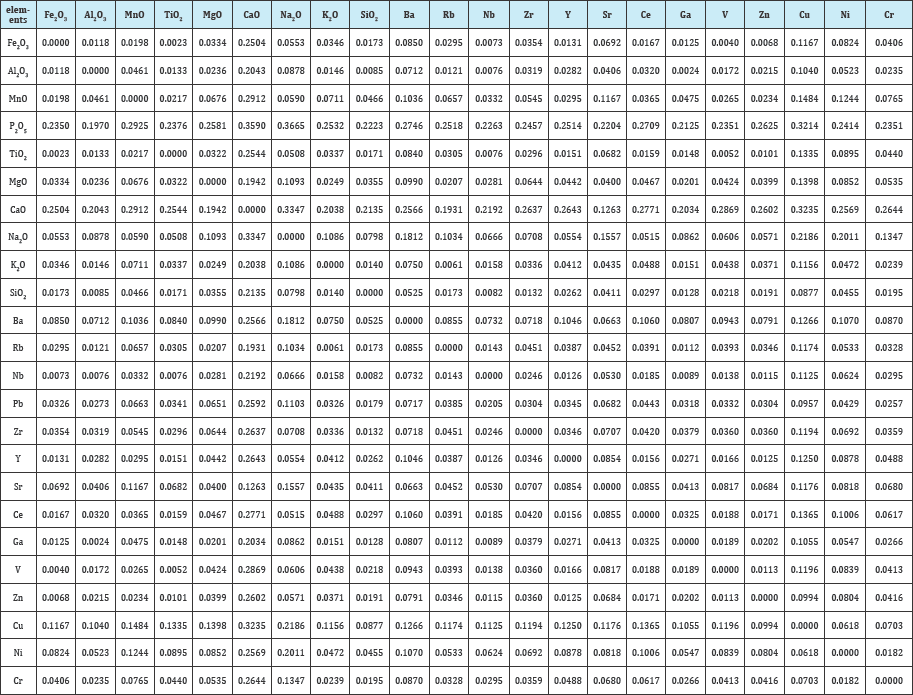
Table 5: The mean composition and the standard deviation in each of the elements of the Paste Compositional Reference Unite (PCRU) of Puig Castellar. (PC)

Table 6: : The mean composition and the standard deviation in each of the elements of the Reference Group (RG) of Riera de Sant Simó. (LAI)
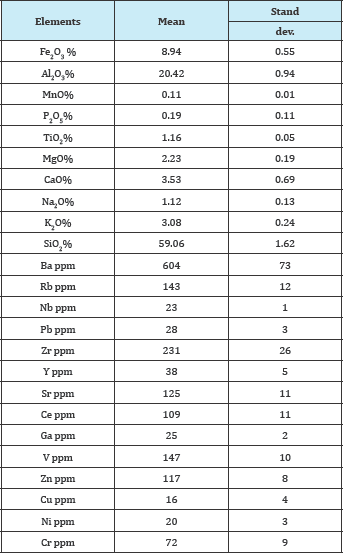
© 2018 Tsantini E. This is an open access article distributed under the terms of the Creative Commons Attribution License , which permits unrestricted use, distribution, and build upon your work non-commercially.
 a Creative Commons Attribution 4.0 International License. Based on a work at www.crimsonpublishers.com.
Best viewed in
a Creative Commons Attribution 4.0 International License. Based on a work at www.crimsonpublishers.com.
Best viewed in 







.jpg)






























 Editorial Board Registrations
Editorial Board Registrations Submit your Article
Submit your Article Refer a Friend
Refer a Friend Advertise With Us
Advertise With Us
.jpg)






.jpg)














.bmp)
.jpg)
.png)
.jpg)










.jpg)






.png)

.png)



.png)






